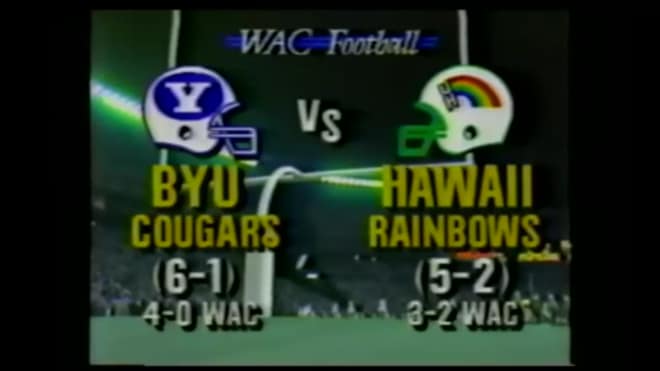Heritage Series: Hawaii vs. BYU, 1989

The history of the spread option offense is a tale of dramatic and immediate impact.
Navy fans know this as well as anyone. It would be difficult to overstate just how moribund the Naval Academy’s football program had become by the time Charlie Weatherbie was hired to replace George Chaump after the 1994 season. The Mids hadn’t had a winning season since 1982, and only once in the following 12 years did they even reach five wins. The program’s outlook was so bleak that Sports Illustrated published a column urging Navy to drop to Division I-AA.
Weatherbie’s hire of Paul Johnson to be his offensive coordinator was just the shot in the arm that the program needed. Johnson’s spread option generated numbers that were almost unheard of in Annapolis. In the first game of the 1995 season, quarterback Chris McCoy ran for more yards (273) than the ’94 team’s leading rusher, Monty Williams, had all season (213). Navy reached the 30-point plateau against I-A competition three times that season, matching their total for the previous decade. In 1996, Navy played in their first bowl game in 15 years, beating a star-studded Cal team in the Aloha Bowl.
Navy had a similar resurgence when Johnson returned as head coach in 2002. The Mids were winless the year before his arrival but were back in a bowl game by 2003. In 2004, Navy won 10 games and finished ranked in the top 25 in both polls. The Mids have built on that success under Ken Niumatalolo, winning 11 games in 2015 and setting the school record for points scored in a season in 2016.
Navy’s experience with the spread option is similar to Georgia Southern’s. The school reinstated its football program in 1982 following a four-decade hiatus, and after two years as a club team, GSU played its first varsity season in 1984. Johnson was promoted to offensive coordinator in 1985, and in only their second year at the I-AA level, the Eagles claimed their first national championship. They repeated as national champions in 1986. When Johnson returned as head coach in 1997, the results were just as instantaneous, with a pair of Southern Conference titles in 1997 and 1998 followed by two more national championships in 1999 and 2000.
For a long time, the spread option was synonymous with Georgia Southern football, much in the same way that Nebraska was known for running the option out of the I-formation. Those GSU teams are relatively well-known among college football die-hards, and many Navy fans are at least somewhat familiar with them. While Navy, Georgia Southern, and now Georgia Tech are the most recognized teams in spread option history, they aren’t the only ones. Less celebrated, but just as significant, are the teams of the University of Hawaii from 1987-1994.
You must be a member to read the full article. Subscribe now for instant access to all premium content.
-
Members-only forums
-
Predict prospect commits with FanFutureCast
-
Exclusive highlights and interviews
-
Exclusive coverage of Rivals Camp Series
-
Breaking recruiting news